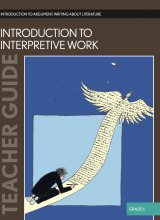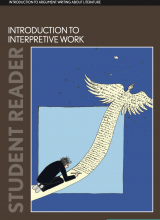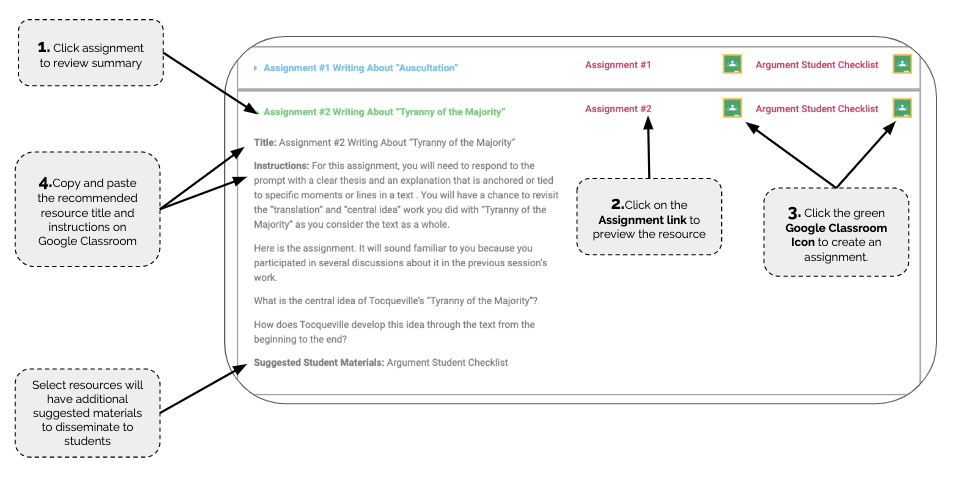Introduction to Interpretive Work - Grade 6
Introduction to Interpretive Work is designed to provide students with an opportunity to deepen their understanding of the kinds of work people do with texts in English. Specifically, the work in this unit provides students with an opportunity to experience the practices of close reading as well as interpretive work distinguished by clear interpretive statements that are supported by compelling explanations and anchored in specific moments in the text. This type of interpretive work falls under the category of argument, as students learn to stake out a clear position and build a careful case for it.


Table of Contents
Writing Tasks
Title: Argument Interpretive Assignment #1 Writing About “Raymond’s Run”
Instructions: For this assignment you will write an argument about “Raymond’s Run” that answers the question in the box below. lt will sound familiar to you because you participated in a discussion about it in the previous session’s work.
Squeaky, the narrator in the story “Raymond’s Run,” has a lot of strong opinions. One of these comes at the end of the story, when she uses the phrase “like being people.
What do you think this phrase means to Squeaky?
Suggested Student Materials: Argument Student Checklist
Title: Argument Interpretive Assignment #2 Writing About “Gryphon”
Instructions: For this assignment you will write an argument about “Gryphon” that answers the question in the box below. It will sound familiar to you because you participated in a discussion about it in the previous session’s work.
In different places throughout the story, Tommy defends Miss Ferenczi.
Why does Tommy defend Miss Ferenczi?
Suggested Student Materials: Argument Student Checklist
Charts for Discussion
Title: “Raymond’s Run” – Comprehension Questions
Teacher Manual Instructions:
Session 2
Take 5-7 minutes to facilitate a whole-class discussion about the three comprehension questions. Use this time to help students articulate their understanding of the characters and the events in “Raymond’s Run.” To verify understanding and to provide an artifact that students can consult in the sessions ahead, consider capturing the class’ answers to the compre- hension questions on a chart.
Title: How is forming an interpretation different from responding to a comprehension question?
Teacher Manual Instructions:
Session 5 and 9
Reconvene the whole class to discuss the question. Capture the class’ thinking about this on a chart. You might organize the responses by creating a simple T-chart, dedicating one column to features of comprehension work and the other to interpretive work. Afterwards, be sure to post this list in the room so that students can consult it as needed. (This is a “working chart,” which means the class will have opportunities to revise and add to it in the sessions ahead. You will use this chart in Session 5 and 9.)
Title: “Gryphon” – Comprehension Questions
Teacher Manual Instructions:
Session 7
Take 5-7 minutes to facilitate a whole-class discussion about the three comprehension questions. Use this time to help students articulate their understanding of the characters and the events in “Gryphon.” To verify understanding and to provide an artifact that students can consult in the sessions ahead, consider capturing the class’ answers to the comprehension questions on a chart.
Checks for Understanding
Title: “Raymond’s Run” – Comprehension Questions Small-Group Discussion
Teacher Manual Instructions:
Session 1
After the reading “Raymond’s Run,” give students time to convene in groups of two or three to work on the questions on the board.
Review the students’ work at the end of the period to determine whether or not they understand the story.
Title: “Raymond’s Run” – Step-Back Question #1 Small-Group Discussion
Teacher Manual Instructions:
Session 2
Review the question with the class and then, to help students reflect back on the work they did to answer it, lead the class through the following cycle of step-back work:
Take a moment to reflect back on the work you did with this question.
Take 3-4 minutes to write down in your notebook a list that answers the following question:
“What are the things you did to answer this question and what was the order—as best you can remember—in which you did them?”
Take your notes to a small-group discussion with two other students. For 2-3 minutes, the three of you should work together to share your lists. During this share out time, be sure to ask questions of one another as needed and, most importantly, to revise or add new items to your list. Your goal here should be to leave this short meeting with a list of things you did that is as detailed and accurate as possible.
Finally, participate actively in a 3- to 5-minute long whole-group discussion about the “what are the things you did” question. Imagine that in this discussion you are working as a whole class to create an even more comprehensive list of the things a reader does when answering a comprehension question.
Title: What are the things you did to answer this question and what was the order—as best you can remember—in which you did them?
Instructions:
Teacher Manual Instructions:
Session 2 and 7
Direct the class’ attention to this comprehension question:
» What happens in the story? In other words, what are the big events in the story and in what order do they happen?
Review the question with the class and then, to help students reflect back on the work they did to answer it, lead the class through the following cycle of step-back work:
Take a moment to reflect back on the work you did with this question.
Take 3-4 minutes to write down in your notebook a list that answers the following question:
What are the things you did to answer this question and what was the order—as best you can remember—in which you did them
Take your notes to a small-group discussion with two other students. For 2-3 minutes, the three of you should work together to share your lists. During this share out time, be sure to ask questions of one another as needed and, most importantly, to revise or add new items to your list. Your goal here should be to leave this short meeting with a list of things you did that is as detailed and accurate as possible.
Finally, participate actively in a 3- to 5-minute long whole-group discussion about the “what are the things you did” question. Imagine that in this discussion you are working as a whole class to create an even more comprehensive list of the things a reader does when answering a comprehension question.
Title: What did you learn today about what Squeaky means by “like being people?
Instructions:
Teacher Manual Instructions:
Session 3
Convene the whole class and ask the question, “What did you learn today about what Squeaky means by “like being people?”
Jot down student ideas on a chart, so these ideas can be accessed later. Encourage students to write their classmates’ ideas in their notebooks, to help them with their upcoming writing assignment.
During this debrief, pause to work with the students to locate and note the page and line numbers of passages they might want to cite.
Title: “Raymond’s Run” Step-Back Questions Small-Group Discussion
Teacher Manual Instructions:
Session 4
Ask students to answer briefly in writing the following “step-back” questions about doing interpretive work independently in class or for home- work:
What did you learn about the text that you didn’t know before the discussion? (To answer this question, look back at your notes to see what you added or how your thinking changed.)
What do you do when you form an interpretation?
How is forming an interpretation different from responding to a com- prehension question?
What did you learn about forming interpretations from our discussion?
Students will have time to share their thinking about these questions at the beginning of the next session.
Title: “Gryphon” – Comprehension Questions Small-Group Discussion
Teacher Manual Instructions:
Session 6
After the reading “Gryphon,” give students time to convene in groups of two or three to work on the questions on the board.
Review the students’ work at the end of the period to determine whether or not they understand the story.
Title: “Gryphon” – Step-Back Question #1 Small-Group Discussion
Teacher Manual Instructions:
Session 2
Review the question with the class and then, to help students reflect back on the work they did to answer it, lead the class through the following cycle of step-back work:
Take a moment to reflect back on the work you did with this question.
Take 3-4 minutes to write down in your notebook a list that answers the following question:
“What are the things you did to answer this question and what was the order—as best you can remember—in which you did them?”
Take your notes to a small-group discussion with two other students. For 2-3 minutes, the three of you should work together to share your lists. During this share out time, be sure to ask questions of one another as needed and, most importantly, to revise or add new items to your list. Your goal here should be to leave this short meeting with a list of things you did that is as detailed and accurate as possible.
Finally, participate actively in a 3- to 5-minute long whole-group discussion about the “what are the things you did” question. Imagine that in this discussion you are working as a whole class to create an even more comprehensive list of the things a reader does when answering a comprehension question.
Title: What did you learn today about why Tommy defended Mrs. Ferenczi?
Instructions:
Teacher Manual Instructions:
Session 8
Convene the whole class and ask the question, “What did you learn today about why Tommy defended Mrs. Ferenczi?”
Jot down student ideas on a chart, so these ideas can be accessed later. Encourage students to write their classmates’ ideas in their notebooks, to help them with their upcoming writing assignment.
During this debrief, pause to work with the students to locate and note the page and line numbers of passages they might want to cite.
Independent Reading
Title: Independent Reading – Individual Planning Sheet
Instructions:
Title: End of Marking Period Self-Assessment
Instructions:
Unit Resources
Title: Argument Interpretive Assignment #1 Writing About “Raymond’s Run”
Title: Argument Interpretive Assignment #2 Writing About “Gryphon”
